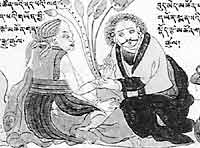|
|
||||
|
The three methods of diagnosis in
natural Tibetan medicine to discover |
||||
|
by Carmen Robustelli There are three methods of diagnosis according to natural Tibetan medicine, to discover and unblock the energy channels responsible for psycho-physical disturbance, the imbalances of the humours and the importance of a correct diet. According to
Tibetan medicine the root cause of all illnesses derived from ignorance,
that is from the wrong way we relate to the nature of things: ignorance
exposes us to different types of suffering, including illnesses.
Ignorance gives rise to negative emotions, such as inconsiderate
desires, hatred, stupidity, which in turn disturb our psycho-physical
balance, thus generating illnesses. Other determining causes are:
incorrect diet, unhealthy behaviour, seasonal influences, externel
interferences. When a blockage in the flow of energies in the channels
or “chakras” is experienced, we begin by experiencing indirect
discomfort which may not at once manifest directly in the form of an
illness, but which can incubate for months or even years. In a healthy
body, energies are balanced and function synergically; once these become
imbalanced, they begin contrasting one another. Many disturbances can be
avoided by taking care of the smooth flowing of energy in these above
mentioned channels and chakras. The balance of the three humours
depends in large part upon a correct diet, which should always be well
balanced. Chiefly, the symptoms experienced as a result of imbalanced humours are: Wind humour: constipation, gastric problems, buzzing ears, cold shivers, weakness, dizziness, pain in the joints and bones, back ache, spasms, memory losses and changes in complexion, anxiety, isolation. Visible signs include a red and rough tongue marked by blisters; discolored urine and a bitter tasting mouth in the morning. Bile humour: stomach acidity, fever, excessive perspiration, shoulder and chest pains, insomnia and lack ofenergy during the day, expectoration. The symptoms increase at midnight and midday. Visible signs include reddish yellow eyes and ears. Phlegm humour: slow digestion, diarrhoea, vomiting, kidney pains, cold shivers, excessive mucus, heavy and confused mind, physical and mental laziness. The symptoms increase late morning and late afternoon. Visible signs include white fuzzy tongue, dull eyes, highly discoloured urine. Both alimentation, behavioural habits and climate determine a certain type of energy in the body. For example, a person under a lot of stress in the workplace may begin to sleep less, defecate when they find time rather than when they should, neglect their family and social life. Such a person begins to depend excessively upon bitter tastings, light and sour food and drink, such as tea and coffee, pork meat, fish, rice, butter, tomatoes, spinach, cabbage, carrots: basically a diet with little nutritional value. Such factors determine an increase of the wind humour, which accumulates and results in blockages in the energy channels, making some parts of the body more vulnerable, such as the lower stomach, bones, hips, skin,heart, ears. If such a person does not change their diet and lifestyle, the wind energy will accumulate to such a point as to manifest the physical symptoms of an illness. The Tibetan doctor uses three methods of diagnosis which are pulse reading, talking to the patient and visual examination. Pulse reading is the most important and requires great ability, a lot of experience and practice. In male patients, the doctor first checks the right wrist with his left hand, first on the surface and then deeply. With the use of the fore, middle and ring finger, the doctor is able to “listen” to the state of health of two of the patient’s organs simultaneously. The doctor then proceeds with the left wrist, using his right hand. This process requires silence and deep concentration on the part of the doctor. Last but not least, he feels both wrists to check and weigh up possible differences. He then proceeds by checking for painful areas along the energy meridians in the body, to confirm his pulse reading. It is only after this first part of the visit that the doctor will then ask the patient some specific questions, even about his or her medical history. The visual examination includes testing of the urine, checking the colour and general condition of the skin and tongue. In children under the age of two, diagnosis is established by further observing the veins and ribbings in both earlobes. |
||||
|
|
||||


